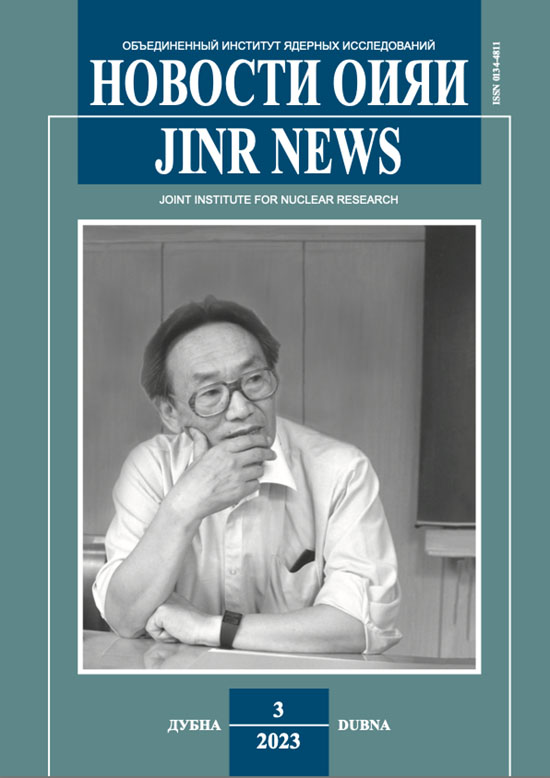
Chiral and deconfinement thermal transitions at finite quark spin polarization in lattice QCD simulations
We study the effect of finite spin quark density on the chiral and deconfinement thermal crossovers using numerical simulations of lattice QCD with two dynamical light quarks. The finite spin density is introduced by the quark spin potential in the canonical formulation of the spin operator. We show that both chiral and deconfinement temperatures are decreasing functions of the spin potential. We determine the parabolic curvatures of crossover temperatures in a limit of physical quark masses.
V.V. Braguta, M.N. Chernodub, and A.A. Roenko. Phys. Rev. D 111, 114508 (2025). DOI: 10.1103/xptn-qgfl

Role of internal kinetic energy in the surface density-overlap region of fusing nuclei
The density overlap between two interacting nuclei results in a change of the internal kinetic energy, which magnifies a repulsive contribution. We investigated to what extent the internal kinetic energy can be calculated using the extended Thomas-Fermi approximation (ETF) with inhomogeneous terms and with surface corrections. The complete fusion reactions involving light and heavy nuclei from 16O to 208Pb are considered as examples. The fusion excitation function is calculated in the framework of the extended quantum diffusion model, using a nucleus-nucleus interaction potential based on the Skyrme energy-density functional. We found that both the fixed strengths of the inhomogeneous terms of the ETF approximation and its semiclassical expansion up to ℏ2 (ETF2) fail to correctly describe the complete fusion process and, thus, the Coulomb barrier parameters. The density and mass-number dependencies for the strengths of these inhomogeneous terms of the internal kinetic-energy density functions are suggested, with which the fusion cross sections are successfully reproduced.
W. M. Seif, V. V. Sargsyan, G. G. Adamian, and N. V. Antonenko. Phys. Rev. C 111, 044307 (2025). DOI: 10.1103/PhysRevC.111.044307

Representations of Hecke algebras and Markov dualities for interacting particle systems
Many continuous reaction-diffusion models on Z (annihilating or coalescing random walks, exclusion processes, voter models) admit a rich set of Markov duality functions which determine the single time distribution. A common feature of these models is that their generators are given by sums of two-site idempotent operators. In this paper, we classify all continuous time Markov processes on {0,1}Z whose generators have this property, although to simplify the calculations we only consider models with equal left and right jumping rates. The classification leads to six familiar models and three exceptional models. The generators of all but the exceptional models turn out to belong to an infinite dimensional Hecke algebra, and the duality functions appear as spanning vectors for small-dimensional irreducible representations of this Hecke algebra. A second classification explores generators built from two site operators satisfying the Hecke algebra relations. The duality functions are intertwiners between configuration and co-ordinate representations of Hecke algebras, which results in novel co-ordinate representations of the Hecke algebra. The standard Baxterisation procedure leads to new solutions of the Young-Baxter equation corresponding to particle systems which do not preserve the number of particles.
A. Povolotsky, P. Pyatov, R. Tribe, B. Westbury, and O. Zaboronski. Ann. Inst. H. Poincaré — Probab. Statist. 61, 967-1020 (2025). DOI: 10.1214/23-AIHP1449

Casimir effect for scalar field rotating on a disk
We compute the vacuum energy of a scalar field rotating with angular velocity Ω on a disk of radius R and with Dirichlet boundary conditions. The rotation is introduced by a metric obtained by coordinate transformation from a rest frame to rotation frame. The constraint ΩR < c must be obeyed to maintain causality. To compute the vacuum energy, we use an imaginary frequency representation and the well-known uniform asymptotic expansion of the Bessel function. We use the zeta-functional regularization and separate the divergent contributions, which we discuss in terms of the heat kernel coefficients. The divergences are found to be independent of rotation. The renormalized finite part of the vacuum energy is negative and becomes more negative with increasing rotation velocity.
M. Bordag, I.G. Pirozhenko. Eur. Phys. Lett. 150, 52001 (2025). DOI: 10.1209/0295-5075/add806

Black holes and thermogeometric optimization
We suggest a finite-time geometric optimization framework to analyze thermal fluctuations and optimal processes in black holes. Our approach implement geodesics in thermodynamic space to define optimal pathways between equilibrium and non-equilibrium states. Since thermodynamic metrics need not be positive-definite, the method ensures a positive thermodynamic length by incorporating simple scale factor into the metric. We show that the thermodynamic length and the scale factor are sensitive to phase transitions in entropy representation, addressing a key gap in Hessian thermodynamic geometry. Additionally, we link the scale factor to the sign of thermodynamic curvature, connecting it to the information geometry governing optimal processes. Our results indicate that optimal fluctuations can drive the evaporation of Schwarzschild and Kerr black holes, which may significantly differ from Hawking radiation. We also explore optimal accretion-driven processes supported by an external inflow of energy.
V. Avramov, H. Dimov, M. Radomirov, R.C. Rashkov , T. Vetsov. Eur. Phys. J. C 85, 587 (2025). DOI: 10.1140/epjc/s10052-025-14303-w